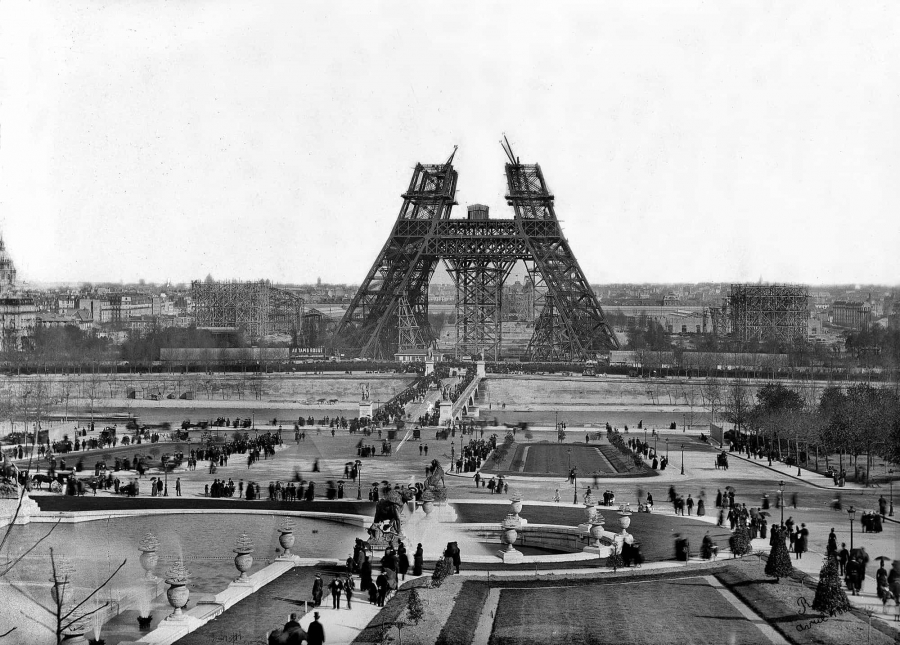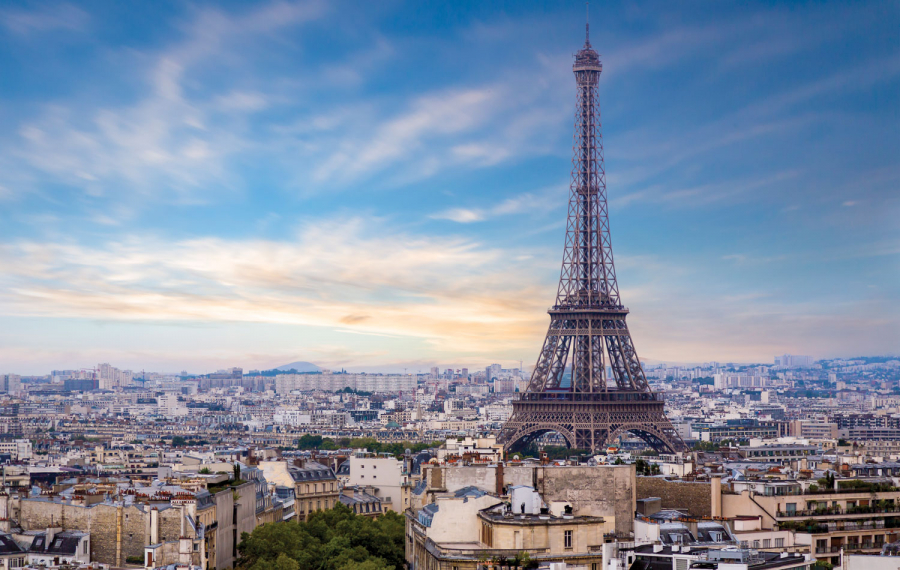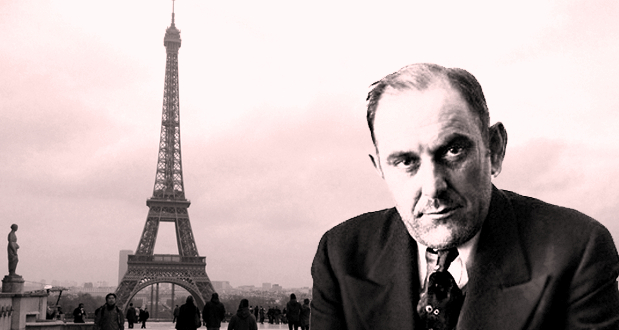After more than 3 months of closure due to the Covid-19 pandemic, the Eiffel Tower reopened to welcome visitors on June 25. Since its inauguration, the Eiffel Tower has become the most visited paid tourist attraction in the world with 6-7 million visitors each year.
Famous as it is, the tower has been controversial in terms of aesthetics and functionality since its completion. Let's find out the ups and downs that the Eiffel Tower has gone through since its inauguration.
1. The Eiffel Tower was originally named differently.
Originally named "300 Meter Tower" (Tour de 300 mètres), this structure was designed and built by engineer Gustave Eiffel and his colleagues from 1887 to 1889 on the occasion of the 1889 World Exhibition, and also the 100th anniversary of the French Revolution.

Gustave Eiffel with a drawing of the 300 m tower.
Upon completion, the tower was named after the patent holder, Gustave Eiffel. But Gustave's birth name was actually Bonickhausen. So if Gustave hadn't changed his name, the tower would have been called Bonickhausen.
2. Gustave Eiffel was not the one who directly designed the tower.
The tower was originally the brainchild of two engineers, Maurice Koechlin and Émile Nouguier, two employees of Gustave's company.
Gustave was instrumental in using his influence to convince politicians to allow the large project to be implemented. At the same time, he was also the main investor, providing the funding to implement the project. Later, for business and promotion convenience, Gustave bought the copyright from two of his engineers and named himself after the tower.

3. The Eiffel Tower was supposed to be built in Barcelona (Spain)
The Eiffel Tower was originally planned to be built in Barcelona, but the Spanish government refused to fund the project. That was certainly a mistake, as the famous tower is currently worth 400 billion Euros, four times the value of the Colosseum (Rome, Italy) and six times the value of the Tower of London (UK).

4. The Eiffel Tower was the tallest structure in the world when it was completed.
The Eiffel Tower was a project beyond the imagination of engineers at that time. At over 300 meters high, the tower was taller than any structure built before. This was a big challenge at a time when engineering technology was limited, and most of the construction process depended on human power.

The tower took 2 years, 2 months and 5 days to complete with the contribution of more than 300 workers. Since its inauguration in 1889, the Eiffel Tower was the tallest structure in the world and maintained this position for more than 40 years.
It wasn't until 1930 that the Eiffel Tower was dethroned by the Chrysler Building in New York (319 m) and the Empire State Building (381 m). Today, many other towers are twice as tall as the Eiffel Tower, such as the Taipei Tower (508 m) and the Burj Dubai (828 m).
5. The Eiffel Tower was nearly demolished many times
Despite its grandeur, the Eiffel Tower was not popular with Parisians at the time of its construction. It had its detractors, especially in February 1887 when it was criticized by some of the greatest artists of the time. The controversy surrounding the tower concerned both its functionality and its aesthetics.
However, upon its inauguration, the Eiffel Tower immediately received a large number of visitors. In the first week, when the elevators were not yet in operation, 28,922 people climbed the tower by stairs.

The construction of the Eiffel Tower faced a wave of public opposition because it was considered to have no practical use and was only for decoration.
Despite its popularity, the tower was originally intended to be a temporary structure and was scheduled to be demolished after 20 years of operation. Aware of the risks and as planned before construction, Gustave Eiffel agreed to conduct experiments as well as set up observation posts in the first year of the tower's operation.
Thanks to the broadcasting antenna installed on top of the Eiffel Tower, it has escaped demolition many times. To this day, the antenna is still used to transmit radio signals from satellites.
6. The Eiffel Tower was almost moved to Canada
The iconic Parisian tower was almost moved to Montreal, Canada, in 1960 after former French President Charles De Gaulle made a secret deal with the Governor of Montreal. The tower was supposed to be part of the Universal Exhibition in Canada, but the move was cancelled after the tower's management company rejected the move.

7. Taking pictures of the Eiffel Tower at night is “illegal”
The sight of the Eiffel Tower shining brightly at night captivates the eyes of many tourists. However, this scene can only be admired, not photographed and posted on social networks.

The Eiffel Tower Operators Company states on their website: “It is perfectly legal to take pictures of the Eiffel Tower during the day. However, the lighting equipment of the tower at night is under the control of the authorities. Therefore, the use of photos taken at night requires the permission of the Eiffel Tower Operators Company.”
The reason is because the lighting system that lights up the tower is considered a work of art and is protected by copyright laws.
8. A scammer once successfully “sold” the Eiffel Tower.
In 1925, a man named Victor Lustig “sold” the Eiffel Tower even though he did not own it. Specifically, this person read an article about the tower’s repair and planned to sell it fraudulently. He went to scrap metal dealers and convinced them to buy the tower. He even asked them to keep the transaction a secret.

Victor Lustig once tried to sell this tower and succeeded.
It seemed like a clumsy plan, but in the end, someone still fell for Victor's trap. A scrap metal shop owner signed a huge check to Victor and waited in vain for the day the building would be demolished and sold. Only when he asked the local authorities did he realize he had been scammed. By this time, Victor Lustig had already fled. The owner was so ashamed that he did not file a lawsuit.
9. Someone once… “married” the Eiffel Tower
An American woman named Erika Aya has a strange syndrome: she only has feelings for inanimate objects, not people. This person "loves" the Eiffel Tower so much that she decided to... marry this tower in 2007 and changed her name to Erika La Tour Eiffel. Erika's humorous "love" inspired American filmmakers to produce the documentary The Woman Who Married the Eiffel Tower.

Erika wants to have her wedding with the Eiffel Tower.
10. The Eiffel Tower has three colors
From a distance, the Eiffel Tower appears to be a single colour, however, this is only an optical effect. So during its construction, Gustave Eiffel had the tower painted in three colours: darker at the bottom and lighter at the top. This technique is still used today.
The tower has not always been brown. The Eiffel Tower is repainted every seven years. Between its original color and its current color, there have been nearly 12 different official colors used, including russet, brown, ochre, and beige.

Painting the Eiffel Tower was no easy task either, it was done entirely by hand and took 18 months to complete.


































